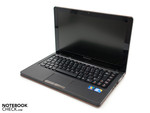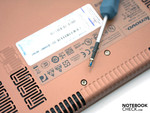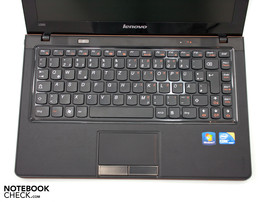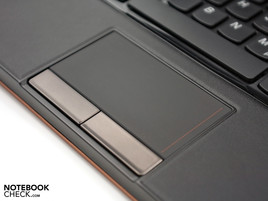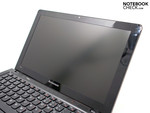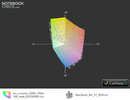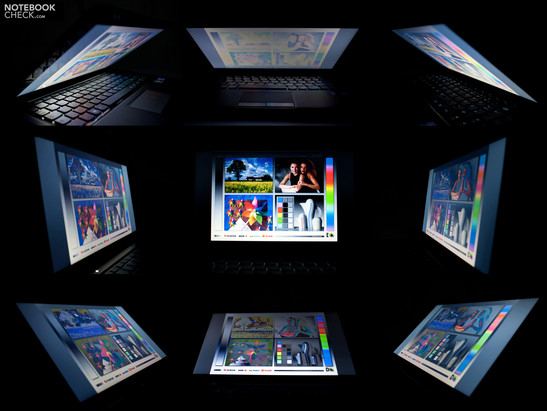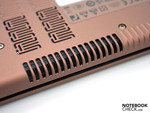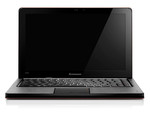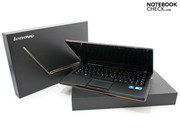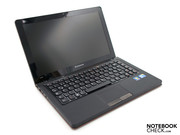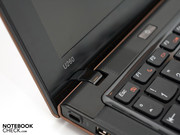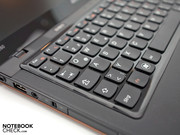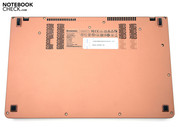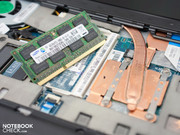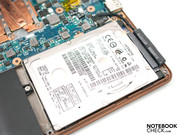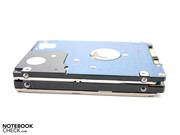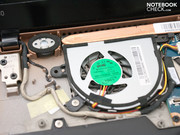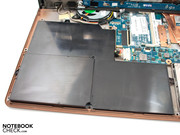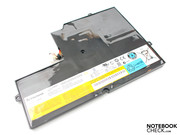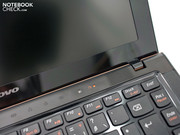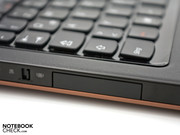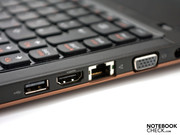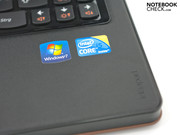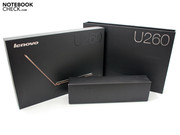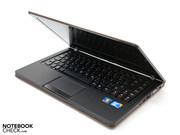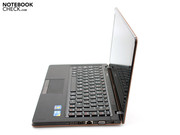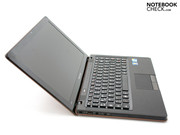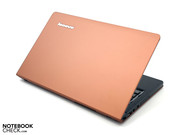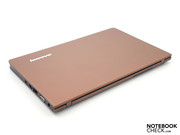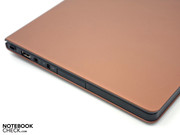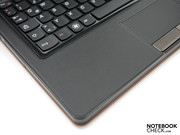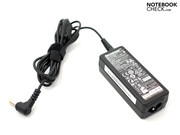Review Lenovo IdeaPad U260 Subnotebook

The new subnotebook from Lenovo which goes by the name of IdeaPad U260, couldn't quite make it to the market prior to Christmas 2010. With a relatively exceptional 12.5 inch display (1366 x 768 pixels, matte surface) the IdeaPad belongs into the subnotebook class. Thanks to high quality materials, such as the aluminum-magnesium alloys, as well as glass and leather, these confirm its positioning in the upper segment of the market. A possible competitor would be the new Apple MacBook Air 11 or the MacBook Air 13.
On the inside of the thin case there is an Intel Core i5 Arrandale processor at work along with a GMA HD graphics chip. The other hardware components are also of a good standard, with 4 GBytes DDR3-RAM, a 250 GByte hard drive, WLAN standards 802.11b/g/b, and Bluetooth 3.0. As with other ultra-thin notebooks, the battery is integrated, and the swapping of the components is relatively difficult.
The entry price for the new elegant subnotebook from Lenovo lies at 999 Euros, whereby it is worth considering that a model including a solid state drive has also been announced. We took a closer look at the device with an elegant-book design and made some comparisons to likely competitors.
Case
The Lenovo IdeaPad U260 stands out thanks to its slender case, which only brings 1.355 kilograms onto the scales with its battery, with dimensions of 318 x 204 x 18 millimeters (W x D x H). This meager weight results to the greatest extent from the use of aluminum-magnesium alloys. Further advantages of this material composition are a high level of stability, and a pleasing feel. Compared to other pure aluminum cases, such as for example that used by Apples MacBook Air 11, the anodized surfaces feel noticeably softer. Depending on personal taste, the color variants available are mocha brown and clementine orange. Lenovo has not fallen short when it comes to the touchpad either, and has opted for a high quality glass surface.
The design is focused on understatement, and appears to have been based on an elegant book. This style is highlighted by the black case sides, overhanging edges of the chassis parts, as well as the single case height of only 18 millimeters. The inside presents a further eye catcher: The palm resting area is completely covered with leather. The material leaves a high quality impression, as well as being exceptionally well manufactured. The small display hinges provide good hold, although they cannot prevent an obvious teetering. Thanks to the weight of the integrated battery, which is primarily beneath the palm resting area, the lower part of the case does not require being held when opening.
The bottom of the U260 doesn't provide any access, and there are only two stickers from Lenovo and Microsoft. In order to access the components, it is first necessary to remove several Torx T9 as well as phillips screws. The first of which require a special screwdriver. Assuming this hurdle has been surpassed, then there is free access to the internal components.
Connectivity
The selection of interfaces is not especially large, nevertheless the most important ports are available. Next to the two USB 2.0 interfaces, the device also offers an analog (VGA), as well as a digital HDMI video output. Savings have been made by Lenovo with the audio interfaces by combining the headphone output and microphone input. Interesting is the plastic cover on the left side of the case, which is often used for a card reader or ExpressCard slot. In reality this merely conceals the Bluetooth module. The labeling on the case makes little sense according to us.
Precisely in this area there is room for criticism, since a card reader would nowadays be a simple way to extend the amount of memory storage, or to easily transfer data from a camera. Similarly a current USB 3.0 port could be expected in this price class. Due to the targeting of the consumer market, the IdeaPad U260 also doesn't offer a docking-port compared to for example the ThinkPad series.
Communication
The communication options don't leave much scope for improvement. Next to Gigabit Ethernet with an Atheros module, the currently up to date WLAN standards 802.11b/g/n (Intel WiFi Link 1000 BGN), as well as Bluetooth 3.0 are supported. For an integrated UMTS adapter the case unfortunately doesn't provide enough space, hence an external solution via USB would be necessary.
Accessories
The black packaging looks good but contains hardly any extras for the device. Next to the subnotebook we were able to find a power adapter with a power cable and sundry manuals. The software included next to the operating system Microsoft Windows 7 Home Premium (64-bit), is not exactly high quality. Trial versions, small standard programs, as well as software from Lenovo and Intel dominate the picture.
Warranty
Out of the box Lenovo provides a 24 months warranty period, including Bring-In-Service. With this service model the device has to be sent to Lenovo in the event of a fault. As an optional upgrade there are a maximum of 36 months available. The entry price for the extension lies at around 80 Euros.
Input Devices
Keyboard
The chiclet style keyboard (individual keys) with the lower edges rounded off has apparently paid off for Lenovo, and can for example be found on the Lenovo IdeaPad Z360 with hardly any changes. The size of the keys of 15 x 15 millimeters is pleasant, the pressure point is clearly noticeable, and the key travel is short. The generous layout of the keys with a separation of the keys of 4 millimeters is convincing. Nevertheless the input device has to contend with one negative aspect: The shift keys are too small for our taste, and the additional key separation distance on the right side was not necessary. With respect to stability the quality of the aluminum-magnesium alloy shows itself. Even strong pressure doesn't cause the keyboard support to bend.
Touchpad
With the touchpad Lenovo wants to underline its premium aspirations, and has adopted a matte glass surface material for this reason. The basis for this input device is provided by a Synaptics touchpad, which supports modern multi-touch gestures, as well as a horizontal scroll bar. The latter of these is marked by a dotted line. The surface offers a very good glide feeling thanks to its rough texture, although it still can't compete with the touchpad on the MacBook Air 11. As can be expected the available settings and options are abundant and can be accessed via the Synaptics software.
Display
The matte display from the Taiwanese manufacturer AU Optronics (AUO) is unusual. With a diagonal length of 30 centimeters, which corresponds to 12.5 inches, this is half way between a 11.6 and a 13.3 inch device. The native resolution is 1366 x 768 pixels in a 16:9 format, whereby higher resolutions cannot be selected. A relatively slim display frame underlines the widescreen format clearly. For external display devices the U260 offers the older VGA, as well as the newer HDMI outputs. The quality of both of these ports can be convincing with a resolution of up to 1920 x 1080 pixels.
The integrated LED back lighting is supposed to provide for an especially thin display lid as well as a good and even illumination of the display. With a maximum brightness of 198 cd/m², and an average value of 189.8 cd/m², the display panel (type: B125XW01) can however not distance itself from the mass of other devices. The possible adversary from Apple even offers values in excess of 300 cd/m². The illumination is even with 87 percent, and there are no signs of any artifacts.
| |||||||||||||||||||||||||
Brightness Distribution: 87 %
Center on Battery: 198 cd/m²
Contrast: 165:1 (Black: 1.2 cd/m²)
41.69% AdobeRGB 1998 (Argyll 3D)
59.2% sRGB (Argyll 3D)
40.15% Display P3 (Argyll 3D)
The additional measured values are about average. The slightly raised black level of 1.20 cd/m² leaves a deep black looking slightly gray. This value also leads to the meager contrast value of 165:1. The representable color space of the IdeaPad U260 can be compared with the use of the ICC file. The sRGB work space cannot even nearly be fully utilized, which speaks for the targeted consumer market. The comparison to the Apple MacBook Air 11 or the MacBook Air 13 shows more or less identical results though.
Thanks to the matte surface of the display, the device seems predestined for use outdoors. In closed areas or in the shade, working is more or less possible without any problems, although the display could be slightly brighter. With the winter sun shining from behind, working already starts to become limited to a certain extent. Along with the brightness, the lack of contrast also lets the colors fade noticeably.
The viewing angle stability is also within familiar areas. The horizontal view stays stable up to about 150 degrees. A color inversion or change doesn't play in to this. The vertical view only requires a small deviation from the ideal position to cause inverted and dimmed images.
Performance
On the inside of the slim chassis there is relatively up to date hardware from Intel at work. The heart is the Intel Core i5-470UM ULV processor with a clock speed of 1.333 GHz and two cores. Using Turbo-Boost it is possible to achieve 1.87 GHz per core. Next to 3 MByte of Intel Smart Cache the processing unit also supports the Hyper-Threading technology, whereby two virtual cores are created. From a performance perspective the i5-470UM falls between the Intel i3-380UM without Turbo-Boost, and the stronger i5-560UM. An upgrade to Intel's newest Sandy Bridge processors has so far not been announced.
For graphics opportunities Lenovo has opted for the integrated Intel GMA HD graphics unit on the processor, and has not adopted a dedicated graphics card. Apple has decided to go in the opposite direction with the MacBook Air 11, and forgoes an up to date processor in favor of a dedicated GPU. The first generation of the GMA HD offered clock speeds of 166 to 500 MHz (with Turbo-Boost). The current GMA HD 3000 (Sandy Bridge) offers a maximum clock speed of 1350 MHz, for the sake of comparison, and can bring a significant improvement in performance with itself.
Furthermore the Lenovo Ideapad U260 is equipped with 4 GBytes of DDR3-1060S RAM from Samsung. This is located in a single slot directly under the keyboard, whereby the maximum has already been included. In addition to this the ULV processor also restricts the clock speed of 1066 MHz to 667 or 800 MHz. A trial RAM module with a clock speed of 1333 MHz (type: OCZ3M13334G) is supported, but remains marginal.
In order to reach the hard drive it is necessary to also remove the upper half of the base unit after the keyboard. As delivered this contains a 2.5 inch drive from Hitachi. Due to the thinner height of only 7 millimeters the number of available alternatives is limited, since a regular notebook hard drive usually has a height of 9.5 millimeters. A short test shows that the case can no longer be closed with a higher HDD variant.
The application performance is the most important and main area of use of the subnotebook. The CineBench R10 (64-bit) benchmark with the CPU in multi-core-rendering achieves an acceptable 4803 points, and lies on a level with older Core 2 Duo variants. Devices with the entry level CPU Intel Core i3-330M in comparison offer around 1700 points more (MSI CX620MX - 6534 points). In the 32-bit version it is even possible to draw comparisons to the Apple MacBook Air 11. This clearly lags behind with 2847 points due to the weaker Intel Core 2 Duo SU9400. The IdeaPad reaches 4168 points in this test.
The system benchmark PCMark Vantage from Futuremark measures the entire system. With 3745 points the tested device belongs among the better devices, of the lower third of devices we have tested. This level also includes devices such as the Dell Vostro V130 (3813 points) with the same CPU/GPU combination, or the Lenovo ThinkPad Edge 11 with Intel Core i3-380UM (3619 points). The subjective performance using Microsoft Windows 7 Home Premium (64-bit) can convince thanks to a quick window changing and short load times.
| PCMark Vantage Result | 3745 points | |
Help | ||
The performance in the synthetic gaming benchmarks underlines the comparatively weak gaming performance. In 3DMark 2006 the U260 cannot keep up with a total score of 1014 points (GPU: 1732 points). Similar devices are the Fujitsu LifeBook T580 with an Intel Core i5-560UM or the Lenovo IdeaPad U160. Notebooks with the same graphics unit and non-ULV CPUs operated in the region between 1700 and 2000 points for the total score. The smooth HD playback locally as well as via YouTube as flash videos can be rated positively though, not considering the limited 3D performance.
| 3DMark 2001SE Standard | 5764 points | |
| 3DMark 03 Standard | 2915 points | |
| 3DMark 05 Standard | 1960 points | |
| 3DMark 06 Standard Score | 1014 points | |
Help | ||
As a storage media the Lenovo uses a 2.5 inch hard drive from Toshiba. The Travelstar Z5K320 (type: HTS543225A7A) offers a total capacity of 320 GBytes at a rotational speed of 5400 rpm. A special feature is the reduced height of only 7 millimeters. The maximum transfer rate of 75.5 (HD Tune Pro) and 70.74 MBytes per second (CrystalDiskMark) with a sequential read operation are not out of the ordinary. Also the access times of on average 18.8 milliseconds lie within the usual range for such a hard drive. For an improvement in performance, modern solid state drives (SSDs) are available. A fitting model would for example be the Intel X25-M SSD with 80, 120, or 160 GBytes of capacity.
Emissions
System Noise
The source of system noise are the hard drive as well as a small cooling fan in the rear area of the case. During idle use these values can vary between 30.4 and 34.4 dB(A) according to our measurements, which makes the device noticeable from time to time. The hard drive stays in the background with 30.5 dB(A), and is occasionally masked by the higher noise level of the cooling fan. Under load the system noise rises to a maximum of 37.0 dB(A), whereby the noise is maintained at a constant level.
Noise level
| Idle |
| 30.4 / 30.4 / 34.4 dB(A) |
| HDD |
| 30.5 dB(A) |
| Load |
| 35.6 / 37 dB(A) |
 | ||
30 dB silent 40 dB(A) audible 50 dB(A) loud |
||
min: | ||
Temperature
A cooling fan along with a copper heat sink provide for cooler conditions on the inside. In an idle state the surface temperatures stay within an acceptable range with a maximum of 30.3 degrees Celsius, and the velvety surface as well as the leather scarcely heat up at all. Under load the knock on effect of the small air vents makes itself noticeable in the form of an air bottleneck. With a maximum of 49.1 degrees Celsius on the bottom surface the heating of the case is clearly noticeable. On the ergonomically important upper side the notebook stays relatively cool and working is not constricted.
(±) The maximum temperature on the upper side is 43.6 °C / 110 F, compared to the average of 35.9 °C / 97 F, ranging from 21.4 to 59 °C for the class Subnotebook.
(-) The bottom heats up to a maximum of 49.1 °C / 120 F, compared to the average of 39.3 °C / 103 F
(+) In idle usage, the average temperature for the upper side is 24.3 °C / 76 F, compared to the device average of 30.8 °C / 87 F.
(+) The palmrests and touchpad are reaching skin temperature as a maximum (34.1 °C / 93.4 F) and are therefore not hot.
(-) The average temperature of the palmrest area of similar devices was 28.2 °C / 82.8 F (-5.9 °C / -10.6 F).
Speakers
The integrated stereo speakers (2x 1 Watt) are located directly above the keyboard. The audio quality does leave room for improvement though. The higher frequencies are most prominent, the volume is not as loud as it could be, and the lower frequencies as well as bass are not represented at all. This constellation even makes most of the worst Netbook speakers competitors. It is therefore recommended to use external speakers or headphones. For this purpose the IdeaPad U260 offers a combination of headphone output and microphone input, as well as an HDMI output. The latter of these can provide a high quality video signal as well the audio signal.
Battery Life
ULV stands for Ultra Low Voltage, whereby the power consumption of the Intel Core i5-470UM is supposed to be reduced to a minimum. Fittingly Lenovo offers its own program called "Energy Management", which offers additional features compared to the Windows 7 power plans. From a hardware perspective the subnotebook for example provides a ambient light sensor, which adjusts the display brightness according to the lighting conditions and the selected profile.
The power consumption (TDP) of the CPU lies at 18 Watts including the graphics unit. In idle use the energy profile "Best Energy Saving" helps to keep the power consumption low. With values between 6.8 and 12.2 Watts the device can convince, and the battery is spared. Under load the power consumption rises to a maximum of 31.7 Watts (Stresstest with Prime95 and Furmark). This additional power consumption is aided by a 4 cell battery with 39 Watt hours of capacity. The Lenovo IdeaPad U260 offers a conventional Lithium-Ion battery, which is not accessible to the user, instead of the announced Lithium-Polymer battery.
| Off / Standby | |
| Idle | |
| Load |
|
Key:
min: | |
The "Classic Test" with the tool Battery Eater makes it possible to get a measurement of the minimum battery run time with full hardware exertion. Which includes maximum display brightness, the least efficient power plan, and WLAN activated. After only 97 minutes (1 hour and 37 minutes) the 39 Watt hours from the battery are used up. In case of wanting to surf the internet with a pleasant level of brightness, then an acceptable 3 hours and 24 minutes are available. The Apple MacBook Air 11 offers an almost identical and scant performance in this scenario.
Even with minimal loading, which can be simulated with the "Reader's Test", the Lenovo IdeaPad U260 cannot really make an impression. With minimum display brightness, deactivated WLAN, and several other energy saving functions, only 4 hours and 50 minutes of battery run time are available. The disadvantage of this test: Working with these settings is only possible with compromises. Altogether the battery life suffers due to the thin construction of the device, and the included battery.
Verdict
The Lenovo IdeaPad U260 leaves a good impression as a subnotebook from the premium segment, even if it has several apparent weaknesses. The case made out of a high quality alloy, as well as the leather surfaces and the touchpad out of glass provide for very pleasant haptics. The thin construction of the case and the light weight are further positive aspects, which do however limit the upgrade options available, as well as the battery life (maximum about 5 hours). The interfaces provide the most important ports, but a card reader would certainly have been welcome.
The keyboard makes a good impression thanks to its generous layout and its stable surface. The unusual 12.5 inch display with a matte surface fits well with the construction, but only provides an average picture quality. The integrated Intel Core i5-470UM can convince in the areas of office performance and power consumption. Further areas of criticism are the increased temperature under load, and the stereo speakers with a less than ideal audio quality.
For 999 Euros the buyer will receive a very elegant subnotebook with convincing arguments for its purchase. A comparison to the Apple MacBook Air 11 or the Air 13 show that both devices have different advantages and disadvantages, and that the decision will eventually likely be reached taking into consideration personal taste and requirements.




